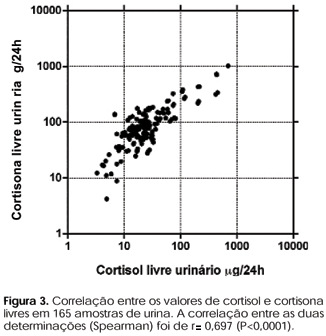Free urinary cortisol (UFF) measurement is one of the most useful screening tests for Cushing's syndrome. Immunoassays employed today by most clinical laboratories present limitations, specially concerning specificity. These limitations restrain a widespread application of the method, as well as the comparison of results obtained by the use of different methods. We present the development and characterization of a UFF and cortisone method based on liquid chromatography and tandem mass spectrometry (LC-MS/MS). A 200µL aliquot from a 24h urine sample is mixed with a solution containing a known quantity of deuterated cortisol and on-line extracted in solid phase (C18). The eluate is transferred to a second C18 column (Phenomenex Luna, 3µ, 50x2 mm) and the isocratic mode elution profile is directly applied to a tandem mass spectrometer model Quattro Micro operating in positive mode atmospheric pressure chemical ionization (APCI). All process is automated and the quantification is performed by isotopic dilution, based on the analyte and the deuterated internal standard peak area ratios. The specificity study showed that all the steroids tested presented cross reactivity of <1% for cortisol and cortisone. Functional sensitivity is <1µg/L for both steroids, and the interassay CV <8%. Recovery and linearity studies were satisfactory and comparison of results obtained using a RIA for UFF and the present method in 98 routine samples showed a correlation of r= 0.838, with the results obtained with LC-MS/MS significantly lower (medians of 22.0 vs. 49.4µg/24h for RIA) (P<0.0001). Reference values for cortisol were defined as values between 11 and 43µg/24h, compatible to those recently described for similar methods. The concomitant measurement of UF cortisone allows the study of the activity of the enzyme 11beta-HSD2 and the diagnosis of the apparent mineralocorticoid excess syndrome. The method represents the first steroid assay of a new generation, based on automated preparative methods and tandem mass spectrometry, described in our country.
Free urinary cortisol; Free urinary cortisone; Liquid chromatography; Mass spectrometry



